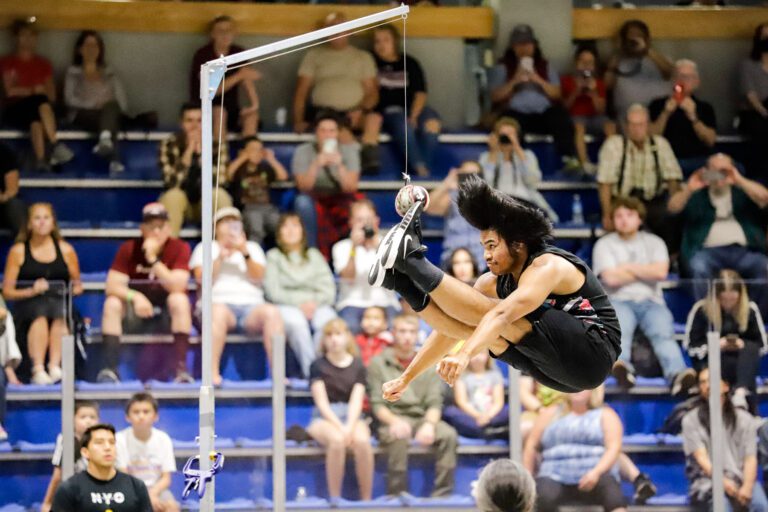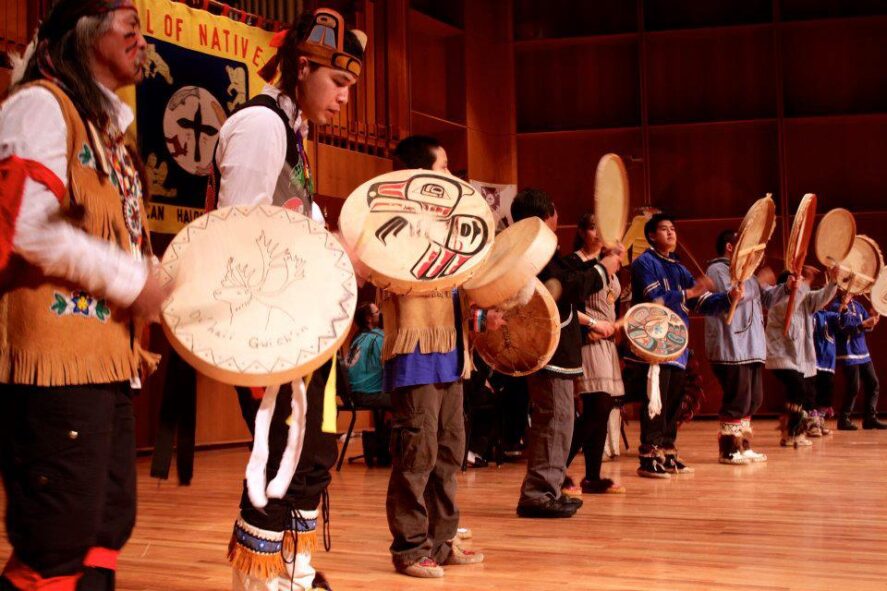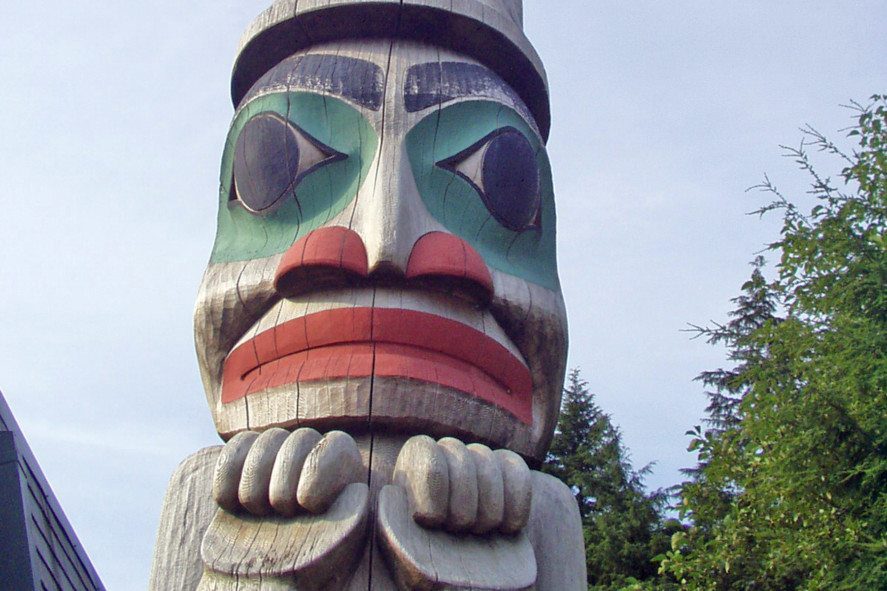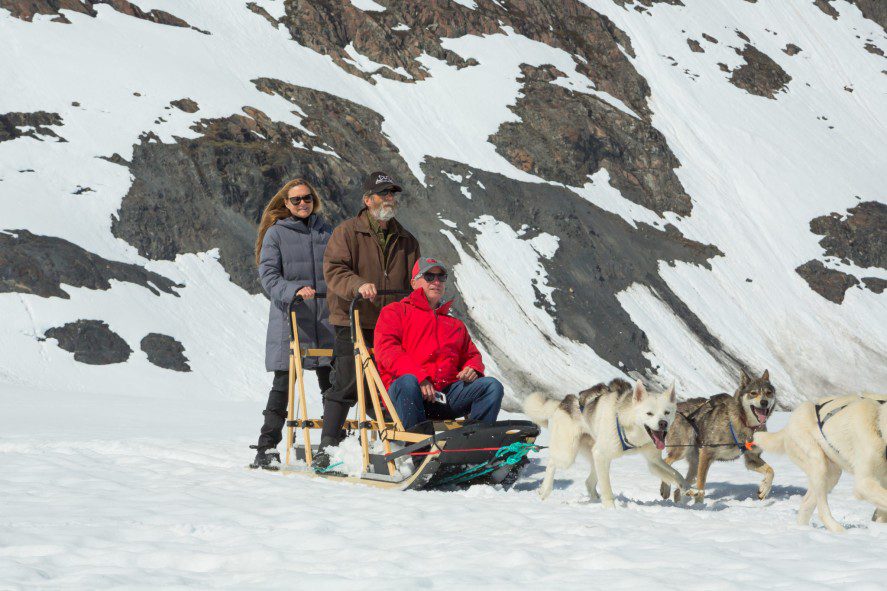Alaska Native people and their traditions and cultures remain the heartbeat of the state, in some way woven into practically all aspects of life here. The best way to get to understand and appreciate the traditions of the First Alaskans of the past and the lifestyles of Alaskan residents of the present is for travelers to immerse themselves into some of the countless opportunities to explore Alaska Native culture.
Savvy Alaska travelers should do their homework before arriving, as there are cultural and community centers and museums with Alaska Native art and craft exhibits in just about every community. There are also events celebrating Alaska Native culture and lifestyles year-round.
Visit the Alaska Native Heritage Center: Anchorage

Alaska Native Heritage Center, Anchorage
One of the first and best entry points to learning about and experiencing Alaska Native culture, traditions and lifestyles and history is at the Alaska Native Heritage Center in Anchorage. The large and impressive Heritage Center has it all, starting with Alaska history covered in many forms: from timelines to stories to movies; artifacts from the past illustrating the clothing, tools, and activities which were part of traditional lifestyles of Alaska Natives; replicas of traditional homes from different Alaska Native regions; and of course, colorful totem poles. Alaska Heritage Center staff are excellent guides, and you’ll connect emotionally to these authentic traditions when you experience first-hand, live Alaska Native dancing, drumming and storytelling and other special events hosted at this hub of Alaska Native culture.
Fairbanks: A Hub for Alaska Native Traditions
Museums and Visitors Center Spotlight Alaska Native Culture
Fairbanks, in Alaska’s Interior, is also home to many special Alaska Native cultural collections and celebrations. The Ethnology & History collection at the University of Alaska Fairbanks’ Museum of the North tells the all-encompassing and fascinating story of Alaska Native traditional lifestyles. And the entryway of the Morris Thompson Cultural & Visitors Center greets visitors with an arch of moose and caribou antlers and spotlights overlapping traditional and modern Alaska Native lifestyles, culture, and art.
The World Eskimo-Indian Olympics

Ezra Elisoff of Juneau takes his turn during the Two Foot High Kick finals at the 2021 World Eskimo-Indian Olympics in Fairbanks. (Jeff Chen/Alaska Public Media)
Since 1961, every summer in mid-July, Alaska Native people from across the state converge in Fairbanks to celebrate traditional survival skills and indigenous traditions as they compete at the World Eskimo-Indian Olympics (WEIO). Most WEIO events have their origins in Alaska Native survival skills of the past. Some of the events are grueling (e.g., “drop the bomb” and “seal hop”), others require grace (the high kicks and one-hand reach events). Some feature simple one-on-one battles (the ear pull and stick pull), and some are straight out of traditional and modern subsistence lifestyles (fish cutting and seal skinning). Beyond the competition, which is fierce but also friendly, WEIO brings together the Alaska Native community, with artists and crafters selling their finest art works and traditional foods, dancing, drumming, and singing, and, of course, a few opportunities for the infamous blanket toss.
Festival of Native Arts
In the spring, Fairbanks’ Festival of Native Arts hosts one of the state’s finest examples of Alaska Native singing and dancing events.

Source: Facebook
Celebration in Juneau & Other Alaska Native Festivals Statewide
In early summer, Celebration in Juneau takes Alaska Native singing, drumming and dancing to the next level with a multiday festival of culture, art, food and more, filling the city with the beating pulse of Alaska Native lifestyles from every corner of the state.
Other Alaska Native festivals to enjoy if you’re in the region include:
- The great gathering of singing and dancing groups at Cama-I in Bethel each March.
- November brings the Athabascan Fiddlers Festival and Gwich’in Athabascan Fiddle Dance to Fairbanks, warming the days and nights with song, dance and fun fiddling.
- The peak of midnight sun in June means the arrival of the Nalukataq Festival at the top of the world in Utqiaġvik (formerly Barrow). Traditional food is at the center of this gathering, but it wouldn’t be complete without a blanket toss, which was traditionally used to spot whales and crews far out into the frigid waters of the north.
Where to See Alaska Totem Poles

Alaska Native Totem Pole
If your travels take you to Southeast Alaska, you’ll likely to discover some of the best examples of Alaska Native totem poles, both impressive and inspiring. You can find the best collections of totem poles at the Totem Heritage Center and the Totem Bight State Historical Park in and near Ketchikan, the Sitka National Historical Park, the Alaska State Museum in Juneau and the Totem Park in Saxman.
Go Dogsledding: Experience an Alaska Native Tradition First Hand

Glacier Dogsledding at Alaska Glacier Lodge, Palmer
One Alaska Native tradition that has remained a staple of modern Alaska life is dog mushing. A team of friendly and seemingly tireless sled dogs are harnessed to a sled and driven by an experienced musher, as their sled glides across the snow with surprising speed. In the past, this form of transportation in Alaska was vital for hunting and trapping, traveling between waypoints and transporting people and goods. Today, mushing is primarily featured in competitions (the epic Iditarod Sled Dog Race held each year in late February/early March to local dog sled sprint races).
This unique display of “dog-power” is incredible to watch. Alaska visitors can experience a rich combination of thrills and smiles for themselves by trying out this good old Alaska fun first-hand. A ride on a dogsled is an unforgettable experience as you cruise across a snowy field to a symphony of yapping sled dogs as your musher calls out his or her commands “Hike! Gee! Haw!”. Don’t pass up the chance. Trust us, you’ll regret it!
